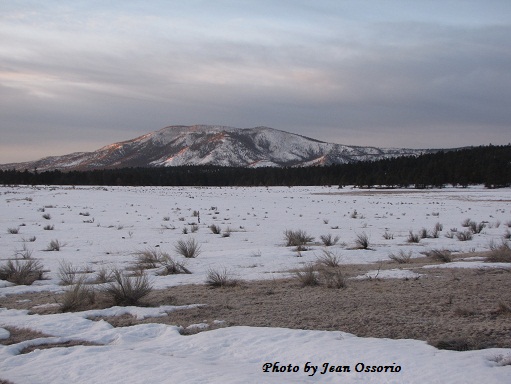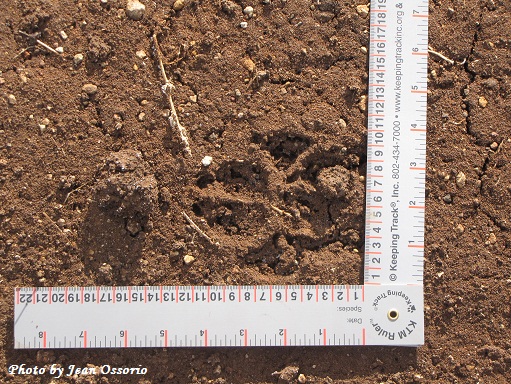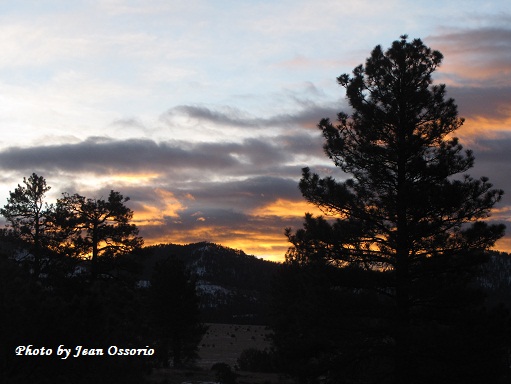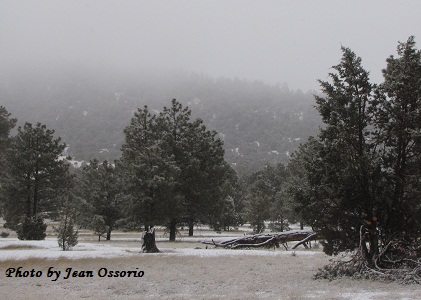Follow the Pack, March 1, 2012
The Continental Divide (See note at the end of this story.) meanders like a serpent across the Gila National Forest in southwestern New Mexico, followed closely by the Continental Divide National Scenic Trail. Hikers on the trail may be unaware of the fact that they pass through the home ranges of at least two families of Mexican gray wolves: the Luna Pack and the San Mateo Pack. Follow the Pack decided to spend part of our annual winter trip in the home range of the Luna family of lobos, near where the Continental Divide Trail crosses a major forest road.
The January sun was sinking low in the west as we entered Luna territory after a long d rive across the grassy Plains of San AgustÃn, home to grassland wildlife like these pronghorn.
rive across the grassy Plains of San AgustÃn, home to grassland wildlife like these pronghorn.
Recent snowfall had left the graded road muddy, slippery, and full of ruts. As we drove up a narrow canyon we encountered more and more icy patches. We hoped to find a place where we could pull off the main road and camp, but deep snow blocked the entrances to side roads. We continued driving in the gathering darkness until we broke out of the forest into an open area where the sun had melted much of the snow. We pulled off and pitched our tent right out in the open, near a lone tree. Racing against the dark, we unrolled our sleeping bags, ate some sandwiches, drank some hot chocolate, and got ready for the long, cold night ahead.
Several times during the night we awoke to hear coyotes howling and barking in the distance. We also heard something even more exciting. Wolf howls pierced the stillness from the southwest. One voice was especially deep and resonant. We wondered whether it was Luna AF(alpha female)1115 or possibly her new compani on, Morgart’s Pack M1155. The Luna alpha female’s mate and the father of her pups had disappeared in April, leaving her to raise the pups with the help of at least one yearling wolf. M1155 lost his original mate when she died accidentally in October. Since the beginning of January he and Luna AF1115 had been traveling together. We were hoping the pair would stay together for the 2012 breeding season.
on, Morgart’s Pack M1155. The Luna alpha female’s mate and the father of her pups had disappeared in April, leaving her to raise the pups with the help of at least one yearling wolf. M1155 lost his original mate when she died accidentally in October. Since the beginning of January he and Luna AF1115 had been traveling together. We were hoping the pair would stay together for the 2012 breeding season.
When we crawled out of our tent in the early morning, it was very cold. We pulled our hats down over our ears and made sure our parkas were zipped up as we watched the sun paint the higher slopes of Elk Mountain with patches of pink and gold.
After breakfast, we walked along the road, searching the mounds of soil pushed aside by the road grader for rocks large enough to use to build a fire ring, so we could safely enjoy a campfire in the evening. There, in deep mud that was now partly dry, we found several wolf tracks. We were thrilled to know that at least one of the wolves had walked right up the road only a few days earlier.
Later in the morning, we hiked down the road toward the Continental Divide. The road was very muddy from melting snow. So much mud stuck to the soles of our boots that our feet seemed to weigh several pounds each! We decided it was easier to walk in the snow along the side of the road than on the road itself. When we reached the spot where the Continental Divide Trail crosses the road, we found it was marked with a little blue symbol on a post. This part of the trail looked like easy walking. The part that climbs to the top of Elk Mountain would be much harder! 
We found a dry place to sit quietly and watch for wildlife while we ate lunch, but saw only a few small birds, mostly juncos and chickadees, in nearby trees.

As the sun sank behind the Continental Divide, we sat by our campfire and wondered whether we would hear the lobos again during the night, howling from the hillside at the left side of this picture. 
The night was quiet at first, but just before two o’clock in the morning we heard wolves howling and barking. We heard them again at 3:40 a.m. and yet again at 6:30, this time from a little farther away. No matter how many times we wake to hear a chorus of wolves howling in the dark, we always sit bolt upright to hear with both ears, so we can better tell the direction of the wolves. This time, like the night before, the song came from the hillside along the Continental Divide.
Middle Fork wolves in the wilderness
The next morning, after a very cold night, with a low temperature of +8?F, we packed up our gear and drove to the home range of our old friends, the Middle Fork lobo family. Recent flight reports showed the pack several miles to the south in the Gila Wilderness, but we hoped that they might have moved farther north since the flight, or that we might at least hear them howl. We set up camp at the same spot just west of Cooney Prairie, where we had camped in early December. (See Follow the Pack for December 31, 2011.) The weather was warm enough that we could enjoy sitting around the campfire in fleece shirts and sweaters, at least until the sun set. 
After a very quiet night, we awoke to a colorful sunrise. We knew that a red and gold sky in the morning often means bad weather ahead, so we set off on a hike soon after breakfast.

A short distance down the road we came to a huge juniper tree. A juniper this large could easily be well over 500 years old. We imagined how many generations of Mexican wolves must have rested in its shadow, before the lobo was completely killed off in New Mexico. Now reintroduced wolves from the Middle Fork pack pass by the old tree as they patrol their home range.

This type of juniper tree gets its name from the fact that its bark resembles the skin of a very large reptile. What kind of juniper do you think it is? (Answer at the end of the story.)

Apparently the Middle Fork wolves were still in the Gila Wilderness. Although we found elk and coyote tracks on our hike, we saw no wolf tracks or scat. By the time we returned to our campsite, dark clouds had begun to gather. We listened to the drumming of woodpeckers and the croaks of ravens, and watched an Abert’s squirrel, with its long, tufted ears, scurry among the trees, as we ate an early dinner.

The next morning we were in for a surprise. New snow was falling, giving every tree and bush a frosting of white.

Cooney Point was almost invisible in the fog and snow.

Cooney Prairie took on a strange, mysterious appearance.

The best surprise of the trip was still to come. As we drove very slowly along the slippery, muddy road to the highway, a small herd of cow elk loomed up out of the fog. 
We watched as they trotted off through the fog. It was a perfect ending for our winter trip in Mexican gray wolf country.
Notes:
1) The Continental Divide is a natural boundary line that separates the rivers and streams that flow into the Gulf of Mexico and the Atlantic Ocean from those that flow into the Pacific Ocean. You can see a map of the Continental Divide and read more about it at this link.
2) The big juniper tree is an alligator juniper, named for the fact that its bark looks like the skin of an alligator. Many birds and animals eat the berries of the alligator juniper. Native American tribes have also used the berries. The wood of this tree is sometimes used for fence posts or for fuel.
3) The Mexican gray wolf reintroduction project annual population survey for 2011 was conducted in January and released on February 3, 2012. The survey showed that the Luna and Middle Fork families of lobos each had at least two surviving pups at the end of 2011.
For more Follow the Pack adventures in lobo country, click here!



